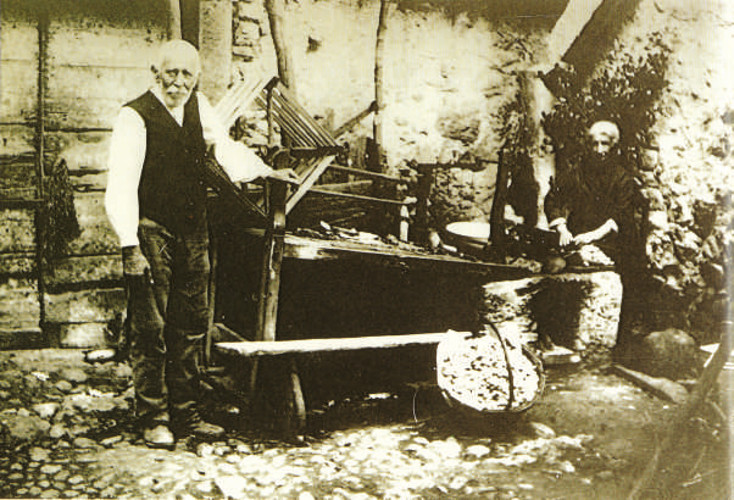Display board 6
THE REELING AND THE SPOOLING OF THE SILK
Reeling consists of all the operations involved in unwinding the strand of silk from the cocoon and turning it into skeins. For this process simple machines were used and, at least until the mid eighteenth century, it took place in the farmers' courtyards or in the farmhouse where the silkworms had been reared.
The chrysalis was killed in a process known as "stoving" (drying in the sun or in ovens) then the cocoons, (known as "gallette") were immersed in water heated to 60 -90°C in special copper fire-heated basins. In the heat the sericin, that sticky substance which kept the cocoons compact, dissolved and the operator, with a light brush or corn beard, could collect the heads of two or four threads (brushing). At this point the "menatressa" came into play, responsible for the final, most delicate phase of the reeling. This operator, attentively following the flow of the thread to prevent or repair any breaks, turned the reel to make the skein.
To be inserted into the actual spinning cycle, the skein of raw silk had to be transferred onto a spool. This operation was known as spooling and, like the reeling, was done by hand in the country until the second half of the eighteenth century. Later the spooling became mechanized and began to be carried out directly in the mills to make the production process more efficient.
Most people in the Rovereto district were employed in these first phases of the silk making. The final phases, in the large throwing mills, were intensive activities which required a limited number of highly specialized operators. specializzati.
In 1766 about 80% of the 5 thousand people employed in making the silk did the reeling and spooling in their homes or in the reeling mills. Whereas only 560 operators worked in the throwing mills.
THE REELING MILLS
Towards the middle of the C 18th the reeling process began to be carried out on an industrial scale in purpose-built structures called reeling mills.Sometimes the machines were concentrated beneath simple open shelters, partly because work was guaranteed for just a few months of the year. In general however the reeling mills were buildings of one or two floors containing long, narrow rooms with numerous large windows to ensure optimum ventilation and lighting.
In the older mills, referred to as "under fire", each basin was heated by a wood-burning stove with a chimney. Consequently the appearance of these buildings was typified by a great number of chimneys, separated by the distance dictated by the production units inside.
Later with the arrival of steam in the early C 19th the chimneys gave way to the monumental smokestacks of the new bigger centralized boilers. At first the steam was used exclusively to heat the basins, but then, with the evolution of technology, it began to be used to turn the reels as well.
Often the reeling mills also had canteens and dormitories. The workers, mostly women and youngsters, were subjected to gruelling shifts which, at the height of the season allowed no breaks, even for festivities.
The largest spinning mill in Trentino was built by Giuseppe Bettini between 1816 and 1818 in Rovereto in the suburb of Lizzanella. Towards the middle of the nineteenth century the factory reached its zenith, counting 240 fire-heated basins. Considering the organization of its production cycle, we can therefore suppose that about 550-600 people were working inside, for a seasonal period of 3 to 4 months.
